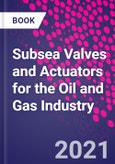Piping and valve engineers rely on common industrial standards for selecting and maintaining valves, but these standards are not specific to the subsea oil and gas industry. Subsea Valves and Actuators for the Oil and Gas Industry delivers a needed reference to go beyond the standard to specify how to select, test, and maintain the right subsea oil and gas valve for the project. Each chapter focuses on a specific type of valve with a built-in structured table on valve selection, helping guide the engineer to the most efficient valve. Covering subsea-specific protection, the reference also gives information on high pressure protection systems (HIPPS) and discusses corrosion management within the subsea sector, such as Hydrogen Induced Stress Cracking Corrosion (HISC). Additional benefits include understanding the concept of different safety valves in subsea, selecting different valves and actuators located on subsea structures such as Christmas trees, manifolds, and HIPPS modules, with a full detail review including sensors, logic solver, and solenoid which is designed to save cost and improve the reliability in the subsea system. Rounding out with chapters on factory acceptance testing (FAT) and High Integrity Pressure Protection Systems (HIPPS), Subsea Valves and Actuators for the Oil and Gas Industry gives subsea engineers and managers a much-needed tool to better understand today's subsea technology.
Please Note: This is an On Demand product, delivery may take up to 11 working days after payment has been received.
Table of Contents
1. Introduction to subsea sector of oil and gas industry2. Subsea valves and actuators standards
3. Subsea ball valves
4. Subsea gate valves
5. Subsea check valves
6. Subsea choke valves
7. Safety valves
8. Flow control valves
9. Remote operated vehicle (ROV) valve operation
10. Subsea actuators
11. Compensation system
12. Material selection and corrosion
13. Valves and actuators sealing
14. Testing
15. High integrity pressure protection system (HIPPS)








